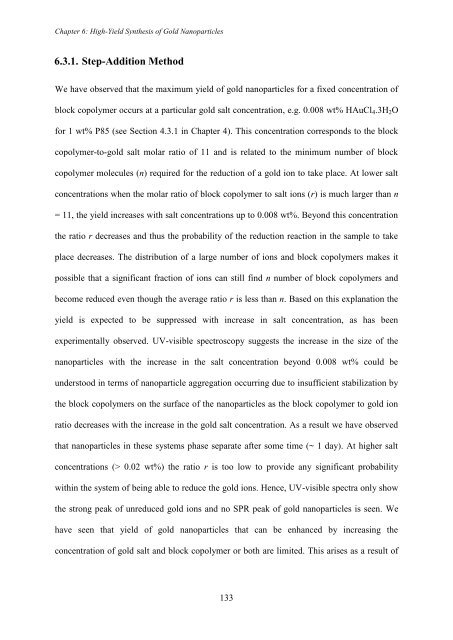PHYS01200704032 Debes Ray - Homi Bhabha National Institute
PHYS01200704032 Debes Ray - Homi Bhabha National Institute
PHYS01200704032 Debes Ray - Homi Bhabha National Institute
You also want an ePaper? Increase the reach of your titles
YUMPU automatically turns print PDFs into web optimized ePapers that Google loves.
Chapter 6: High-Yield Synthesis of Gold Nanoparticles<br />
6.3.1. Step-Addition Method<br />
We have observed that the maximum yield of gold nanoparticles for a fixed concentration of<br />
block copolymer occurs at a particular gold salt concentration, e.g. 0.008 wt% HAuCl 4 .3H 2 O<br />
for 1 wt% P85 (see Section 4.3.1 in Chapter 4). This concentration corresponds to the block<br />
copolymer-to-gold salt molar ratio of 11 and is related to the minimum number of block<br />
copolymer molecules (n) required for the reduction of a gold ion to take place. At lower salt<br />
concentrations when the molar ratio of block copolymer to salt ions (r) is much larger than n<br />
= 11, the yield increases with salt concentrations up to 0.008 wt%. Beyond this concentration<br />
the ratio r decreases and thus the probability of the reduction reaction in the sample to take<br />
place decreases. The distribution of a large number of ions and block copolymers makes it<br />
possible that a significant fraction of ions can still find n number of block copolymers and<br />
become reduced even though the average ratio r is less than n. Based on this explanation the<br />
yield is expected to be suppressed with increase in salt concentration, as has been<br />
experimentally observed. UV-visible spectroscopy suggests the increase in the size of the<br />
nanoparticles with the increase in the salt concentration beyond 0.008 wt% could be<br />
understood in terms of nanoparticle aggregation occurring due to insufficient stabilization by<br />
the block copolymers on the surface of the nanoparticles as the block copolymer to gold ion<br />
ratio decreases with the increase in the gold salt concentration. As a result we have observed<br />
that nanoparticles in these systems phase separate after some time (~ 1 day). At higher salt<br />
concentrations (> 0.02 wt%) the ratio r is too low to provide any significant probability<br />
within the system of being able to reduce the gold ions. Hence, UV-visible spectra only show<br />
the strong peak of unreduced gold ions and no SPR peak of gold nanoparticles is seen. We<br />
have seen that yield of gold nanoparticles that can be enhanced by increasing the<br />
concentration of gold salt and block copolymer or both are limited. This arises as a result of<br />
133

















